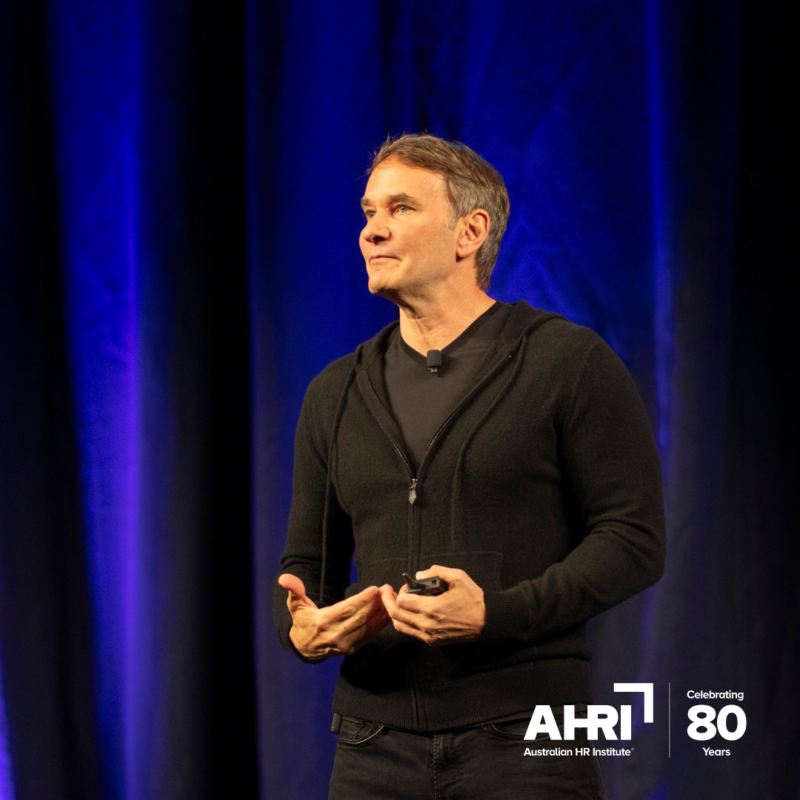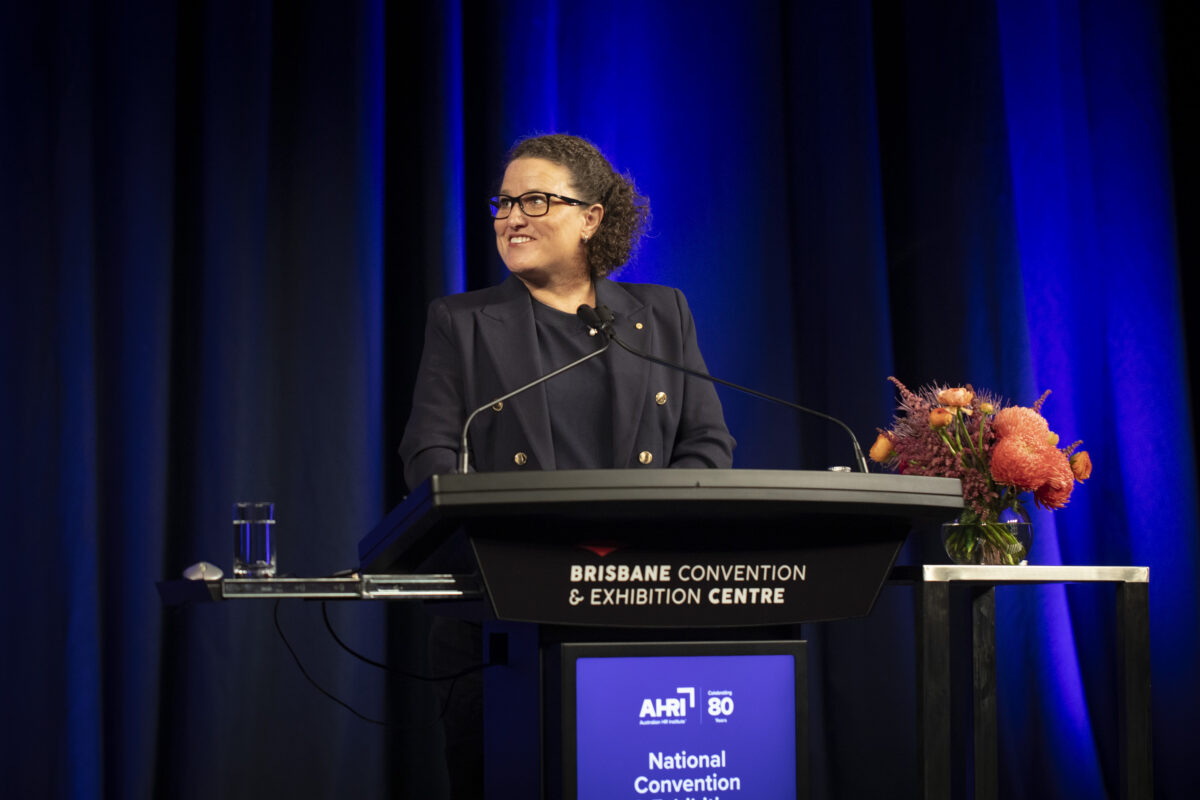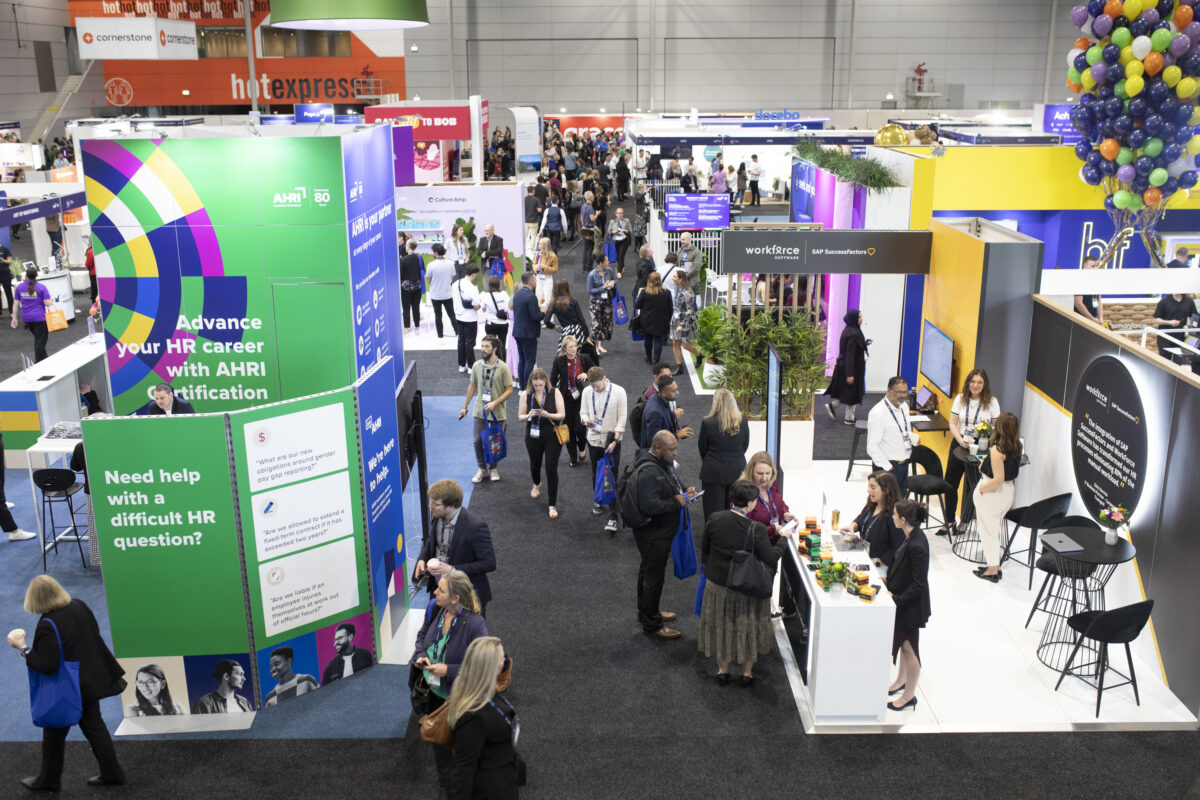As this year’s AHRI National Convention and Exhibition kicks off, calls to reimagine work for today’s complex employment landscape take centre stage.
HR professionals need to start seeing themselves as the architects of organisational transformation, says Keith Ferrazzi, author, entrepreneur and Chair of US-based consulting and coaching firm Ferrazzi Greenlight.
“We have an invitation, right now, to re-engineer the way we work,” Ferrazzi told an audience of HR professionals on the first day of this year’s AHRI National Convention and Exhibition (NCE).
From the proliferation of generative AI to the plethora of new industrial relations responsibilities placed on HR, the last 12 months have seen unprecedented upheaval to organisational structures and capabilities. Navigating this uncharted terrain requires rethinking our strategies.
Speakers at this year’s NCE delved into a far-ranging array of issues impacting the HR sphere. However, one common thread that united these discussions was the role of HR in redesigning work for the better.
Here is a snapshot of the expert insights attendees heard on the first day of the event.
1. Develop a new social contract for teams
In his keynote address, Ferrazzi explored the ways in which organisations can help their teams to thrive in the new world of work by creating a culture of ‘teamship’ and ‘co-elevation’.
During the pandemic, HR had to enable the transformation of the ways we work and collaborate, he says. This endowed them with a unique and powerful elevation within their organisations.
“During that period, I was fearful. I was fearful that, with all of this massive disruption, and all of this massive change – and, in a sense, all this wonderful opportunity – that we would come out of it and then crawl out of the rubble and go back to work.”
Instead of going back to work, Ferrazzi wants HR to go forward into work.
He envisions HR as “sherpas”, leading teams into new work environments. This transition necessitates a re-evaluation of the social contracts that govern employee interactions and, ultimately, co-designing a new social contract fit for today.
“What is our ‘old’ social contract? It’s all hub-and-spoke to the leaders,” he says.

“We salute leaders, we pedestalise individualistic leaders – that’s the way we currently organise leadership. We teach leaders how to give feedback, but do we teach leaders how to have their teams give each other feedback? We teach leaders how to hold folks accountable, but do we teach leaders how to help their teams hold each other accountable?”
Particularly now that remote and hybrid working have become par for the course, teams need to be empowered to ‘co-elevate’ one another rather than seeing themselves as individual followers of a leader.
“The highest-performing teams have each other’s backs. That’s where we need to be,” he says.
Redesigning the social contract in this way involves mutual consensus on points such as communication frequency, how to foster open discussion, identifying potential risks and how you’ll help each other get back on track if you fall behind.
Each organisation’s recontracting process will be unique, fostering an environment where accountability flourishes. This shift can empower teams to thrive in the evolving work landscape.
2. Embrace generative AI
Generative AI is the most disruptive technology we have ever seen in our lives, according to Dr Sean Gallagher, Director at the Centre for the New Workforce and AHRI Future of Work Advisory Panel member.
At the time of last year’s Convention, few could have predicted the pace and extent of progress in this field. Just 12 months later, generative AI is just about all anyone can talk about.
A slew of recent advancements in this technology are prompting organisations and their HR teams to reconsider their approach to almost every aspect of their work.
“AI was expected to reach the median level of human creativity around 2037. It achieved that this year,” says Gallagher.
“It wasn’t expected to be able to write at a top-quartile human level until 2050. It’s now expected to get there next year. And AI wasn’t expected to feel emotions until 2055. The new estimate is as early as 2030.”
The speed of change makes it understandable that some individuals feel threatened by or fearful of the technology, whether that’s due to job security or the fear of falling behind in the rapidly shifting world of work.
The ambiguity surrounding the technology means that leaders might be hesitant to allow their workers to integrate AI into their daily operations, worrying it could reduce the quality of their work or introduce privacy or cybersecurity risks.
However, Gallagher stresses that this attitude will likely result in organisations being left behind in the new, AI-driven world of work.
A US study found that seven in 10 workers who use ChatGPT at work are not telling their employers about it. Australian workers reported being more open, with 50 per cent sharing their use of AI with colleagues and 43 per cent telling their supervisors.
However, Gallagher believes it’s important to bring AI out of the shadows, as there are plenty of efficiency gains to be made.
He points to an MIT study involving two groups of professionals completing writing tasks, where only one group was allowed to use ChatGPT to help them complete the task.
Participants who used ChatGPT completed tasks 11 minutes faster, with an 18 per cent increase in output quality.
“Just as importantly – and this is a key take home message for HR leaders – is that when empowered to use these tools, workers reported much higher levels of job satisfaction and much higher levels of self-efficacy, meaning they felt less threatened by it and they felt more empowered.”
“AI was expected to reach the median level of human creativity around 2037. It achieved that this year.” – Dr Sean Gallagher, Director at the Centre for the New Workforce
HR therefore needs to be more proactive in helping employees explore and implement these models. This will assist in quelling fears about the technology and fostering a culture of openness and curiosity about AI.
With generative AI’s potential to shave time off of our regular tasks, organisations should also be thinking about how they want their employees to spend that additional time, he says.
Gallagher’s vision of the future of human work in the AI age boils down to four main areas:
- Navigating uncertainty. “We can figure out the future when we’re working together with lots of other different humans who have different perspectives and vantage points.”
- Abstract thinking. Humans are wired to be curious and creative, he says. This makes human input far preferable to AI when it comes to thinking outside the box.
- Profound understanding of people. Now that AI can take care of the less-human-centric parts of work, humans can focus on the nuances of relationships with various stakeholders and how to strengthen them.
- Context, meaning and judgement. While AI can be a useful tool in decision-making, this must always be owned by people, says Gallagher.
“Fortunately, these are the highest-value-creating activities in every organisation,” he says.

3. Unlock employees’ best and most sustainable work
To unpack strategies to achieve optimal performance in 2023, Aaron McEwan FAHRI, Vice President of Research and Advisory at Gartner, cast NCE attendees’ minds back to May 2020.
The upheaval brought about by the COVID-19 pandemic brought with it an unexpected development, he says: a positive surge in employee performance.
“We found that the vast majority of employees did perform incredibly well, and they continue to perform well today. But at what cost?”
The catch, he says, is that this level of performance is inherently unsustainable. Employers themselves seem to recognise this. In Gartner’s research, cited by McEwan, 96 per cent of HR professionals reported that employees met or exceeded their performance targets last year. Meanwhile, just 58 per cent are confident they can meet or exceed their 2023 performance targets.
Performance should be assessed according to two variables, he says: whether the employee is giving their best work, and whether it is sustainable. If HR cannot answer ‘yes’ to both these questions for their people, it’s time to consider a new approach to performance optimisation.
Based on Gartner’s research, McEwan suggests a strategy called ‘performance cues’. These cues allow employees to have agency over how they achieve their goals while also giving them signals to guide their choices, or ‘cues’.
The three most important performance cues are:
- Path cues. These are signals to help employees understand the collective objectives that the organisation is working towards and give them context for decisions.
- Pace cues. As well as ensuring employees are giving their best work, it’s also crucial to ensure their pace is sustainable. HR should therefore build an understanding of wellness at work to help employees choose a sustainable pace.
- Progress cues. These are signals to help employees learn what they are doing well or not so well, giving them crucial feedback and recognition for their efforts.
4. Cultivate psychosocial safety
Since the recent introduction of a new model Code of Practice on managing psychosocial hazards, some employers have been scratching their heads wondering what ‘psychosocial risks’ actually look like, and the nature of leaders’ new responsibility to manage them.
With Australia currently ranked as one of the most stressed-out countries in the world, the need for employers to assess and control these risks is only growing more urgent.
Dr Michelle McQuaid, Founder of the Wellbeing Lab, addressed a packed-out room of attendees hoping to get a better handle on their new obligations when it comes to psychosocial safety.
According to research by The Leaders Lab in collaboration with AHRI, some of the most common psychosocial hazards experienced by employees include harassment, poor supervisor support, unachievable job demands and inadequate reward and recognition.
Interestingly, the number one source of psychosocial risk cited by survey respondents was a lack of role clarity.
The importance of job clarity was something McEwan also addressed in his session, saying, “We liken it to somebody going on a hike. You know the conditions when you start out. You can see everything in the pathway ahead, but if the weather changes and a storm rolls in, all of a sudden those conditions aren’t quite as clear. We think this is where a lot of employees are currently sitting.”

Psychosocial hazards contribute to poor mental health, burnout and low job satisfaction, says McQuaid. With the new Code of Practice in place, employers are obliged to manage these risks, but they are not expected to eliminate them entirely.
“Every job involves some psychosocial hazards – there’s not a job in the world that doesn’t have some elements of this,” she says.
“[The new legislation] is about acknowledging that many of our jobs have multiple hazards in them, and [thinking about] how we are going to navigate these with more care for ourselves and each other as we go about our roles at work.”
McQuaid stresses that there should be no shame or finger-pointing in flagging and managing these hazards, since the fact that they exist is not necessarily a sign of intent or negligence on the part of the employer. What’s more, all employees, including leaders and HR, are subject to these psychosocial risks – therefore, managing them needs to be an open and collaborative process in order to be successful.
It’s important to note that these hazards are subjective, she says; what seems like a manageable risk to one employee might cause stress or burnout in another.
To help employers and HR get a handle on the psychosocial risks that are impacting individual employees, McQuaid suggests conducting a simple interview, or ‘Safety Check Chat’, by asking the following four questions:
- What’s working well?
“We always start with the strengths so we can feel confidence and self-efficacy that we can keep moving forward and trying again,” says McQuaid.
Even if a given project did not go as planned, ‘We gave it our best shot’ is as good an answer as any, she says.
- Where are we struggling?
“The more we can normalise struggle in our workplaces simply as part of the way we learn and grow, the better the outcomes we get for ourselves and others,” she says.
“There’s no shame in struggling. Struggling is how we figure out how to get better.”
- What are we learning?
“We are very outcome-focused in workplaces. But most of our outcomes are pretty short-lived,” she says.
“What we do get to hang on to is the learnings, because we get to take it forward to the next thing, and the next thing and the next thing.”
- What would you try next?
This is a crucial question to ask, says McQuaid, as the answer will be demonstrative of your ability to learn through struggle and continue to evolve ways of working without judgement.
By asking these questions and creating an environment where employees feel safe to express their concerns, HR can actively contribute to enhancing the overall health and performance of the workforce.
These insights only scratch at the surface of what was covered throughout day one of AHRI’s NCE. We’ll be wrapping up day two tomorrow, so keep an eye out in your inboxes. And make sure to follow AHRI on LinkedIn and Facebook to stay in the loop with more expert advice as we post throughout day two.


I like this round up – thankyou. I do disagree with the notion that AI will feel emotions by 2030. AI will not feel emotions. Generative AI will just get better at mimicking them. And please – do not underestimate the Privacy and Security concerns – they are very real. Don’t get me wrong there are very useful aspects to AI, and it’s use (in all spheres of business) should continue to be discussed and interrogated, but at the very least introduce a Policy around responsible use, privacy, classification of information and potential risks and help raise awareness. It is… Read more »
AI is 2-way, stay safe.